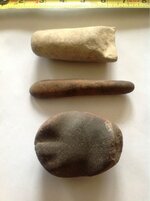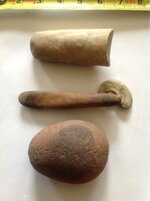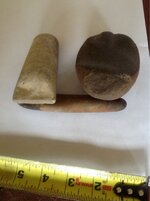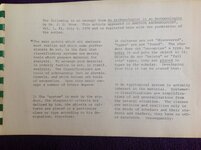eppingera
Full Member
- Aug 29, 2012
- 124
- 77
Hello all!
Looking for opinions on these items. The 2 outside ones were found in Howard County, MO on a farm where we have found numerous projectile points (mostly broken) and possible pottery shards. The round-ish one fits perfectly in the palm with the fingers fitting in the grooves on the underside. The end is damaged as if it was used as a hammer. The cylindrical one I have no idea about, it is a strange looking rock but doesn't look natural to me. The middle one was found on a Missouri River mud flat. Any ideas or opinions?
Thanks!
Looking for opinions on these items. The 2 outside ones were found in Howard County, MO on a farm where we have found numerous projectile points (mostly broken) and possible pottery shards. The round-ish one fits perfectly in the palm with the fingers fitting in the grooves on the underside. The end is damaged as if it was used as a hammer. The cylindrical one I have no idea about, it is a strange looking rock but doesn't look natural to me. The middle one was found on a Missouri River mud flat. Any ideas or opinions?
Thanks!
Attachments
Upvote
0











